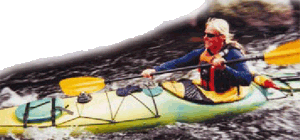
![]()
Volume 6, No. 1
Promoting Cooperation to Maintain and Enhance
Environmental Quality in the Gulf of Maine
|
||||||||||
|
Regular columns |
|
Archives |
|
About |
Wave after wave of marine intruders
are changing the face of coastal waters
Ships transplant most species, but
smaller, unregulated carriers are on the rise
By Andi Rierden, Editor
Meet Joe Rocker. The shiny interloper, identified by its
V-shaped body and five spines behind the eyes loves to eat plants, insects,
clams, oysters, worms, snails, urchins, sea stars, fish, crabs and more. And
what a traveler. Known formally as the European green crab or Carcinus
maenas, it was first recorded in Long Island Sound in the early-1800s and
has been feasting its way north ever since. Marine biologists were shocked
when the crab reached the cold waters of Maine, then in the 1950s it
appeared in the Bay of Fundy, before shimmying up to the Gulf of St.
Lawrence. Today, Joe Rocker, a nickname coined by New England fishermen in
the early 1900s, has the distinction of being one of the most prolific crabs
in the Gulf of Maine.
But a more recent arrival may cramp the crab's style. The Asian shore crab, Hemigrapsus sanguineus, was discovered in New Jersey in 1988. Measuring two to three inches wide, it has spread as far north as Maine and as far south as North Carolina. Like the green crab, this Japanese import reproduces in far greater numbers than native species. The crab dines on worms, barnacles, shellfish seedlings, algae¾just about anything it can get its claws on. It has even been known to eat green crabs.
With their voracious appetites and tolerance for low and high salinity and a wide-range of temperatures, the two aquatic intruders are every marine biologist's nightmare. Like unwanted houseguests, crabs and other marine life introduced outside their native range can become major pests in their adopted ecosystems.
The long-settled European green crab has been blamed partly for the demise of the softshell clam industry in New England and Nova Scotia, destroying commercial shellfish beds and preying on large numbers of native oysters and crabs. Meanwhile scientists like Dr. Nancy O'Connor, a professor of biology at the University of Massachusetts Dartmouth, have observed declines in native crab populations that share the same habitat as the Asian shore crab.
Longard Award winner gives meaning and roots to age-old philosophy
Editor’s note: Art Longard was an ardent believer in citizen volunteers as instruments to ensure the sustainability of the Gulf of Maine’s natural resources and in the need for government and citizens to work together to achieve those goals. As one of the seven original founders of the Gulf of Maine Council, he committed countless hours to the conservation of marine life in the Gulf of Maine. He died of cancer in 1997. In his honor, the Council bestows the Art Longard Award each year on an outstanding citizen volunteer living within the Gulf’s watershed.
By Andi Rierden, Editor
Arthur Bull is sitting in the Bay of Fundy Marine Resource Centre (MRC) in Cornwallis, Nova Scotia describing how the soon-to-be launched Saltwater Network will make it possible for nonprofit stewardship groups in the Gulf of Maine to exchange resources. The project is evolving after years of informal collaborations between marine resource groups like the MRC, the Cobscook Bay Resource Center and the Stonington Fisheries Alliance in Maine.
 At
left: Arthur Bull, advocate for the small boat fisheries, received the Gulf
of Maine Council's Longard Award for 2001. Photo: Andi Rierden.
At
left: Arthur Bull, advocate for the small boat fisheries, received the Gulf
of Maine Council's Longard Award for 2001. Photo: Andi Rierden.
The concept is similar to Bull’s work here along the Bay
of Fundy, where his attempts to create alliances to improve the economic and
ecological conditions in coastal communities are well known. As part of the
new network, organizers hope to share success stories here with other areas
in the Gulf and vice versa. The Henry P. Kendall Foundation based in Boston
is providing the initial funding.
“The image we keep coming back to is how, in the marine environment, there
is this process of upwelling, where the nutrients circle around,” says Bull,
the Gulf of Maine Council’s Art Longard Award recipient for 2001. “All of
these groups are like nutrients that are inherently and intrinsically
connected. But what has been missing is a network to mobilize those groups.”
Feature Articles |
 Natalie Springuel will lead a kayaking expedition spanning the Gulf of Maine. Full story inside. |